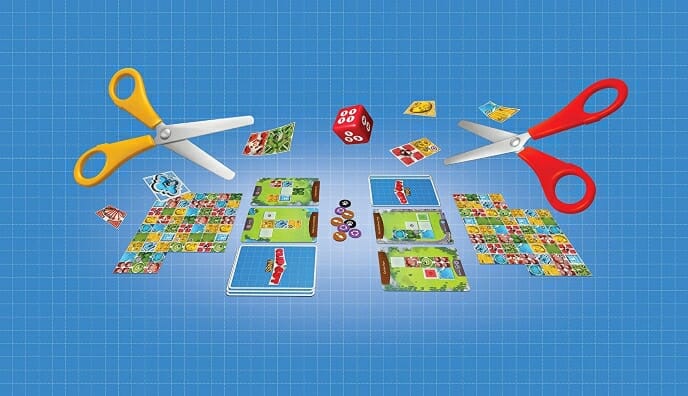ClipCut Parks Will Only Hold Your Interest If You’re Really into Scissors and Cutting Things
Games Reviews board games
Silver and Gold was one of my favorite games of 2019, taking the familiar concept of Tetris-like shapes and using that to build a quick-moving game with simple scoring and a low barrier to entry for non-gamers. ClipCut Parks, one of five nominees for the Origins Award for Best Family Game this year, is a sort of kids’ version of Silver and Gold that replaces the flip-and-write mechanic—where you’d flip a card and fill in squares on your objective cards—with a “roll-and-cut” mechanic, where you roll a die and make several cuts to your giant grid of park squares, then use the pieces that fall free to cover squares on your personal cards. It’s a bit too simple for even casual adult gamers, but is great for playing with kids who love using scissors (pretty much every little kid I’ve ever met) and who are working on spatial recognition or pattern matching.
ClipCut Parks plays two to four players and gives each player five park cards at the start of the game, with each card showing some pattern of five or six squares. Some squares are blank, while some show a specific color or symbol that players must match. Each player also has a paper divided into 56 squares in four different colors, with some also showing those symbols you’ll find on park cards. On each turn, one player rolls the die, which shows one or more numbers (e.g., 1-1-2, 2-2, or just 4), and players must make distinct cuts of those lengths on their paper. So if the roll is 1-1-1-1, players must make four separate cuts, one square-side in length, on their paper. You can’t combine those to make a single cut of length 4, however. You take any pieces that fall off your main sheet and place them on your cards, if possible, to cover as much of your parks as you can. You must match colors and symbols, and can’t place pieces that don’t fit or over other pieces you’ve already placed. There are also small brown bridge symbols between some squares on park cards, showing that they can only be covered by a connected section of paper. Anything that falls off your main sheet and can’t be placed is crumpled up and set aside; it may count against you if there’s a tie at the end of the game.

When you finish either of your two parks, you gain a bonus and reveal the next card from your deck of five. Bonuses can include gardener tokens, which let you ignore the color on one square when placing a paper piece over it; wildlife/recycling tokens, which let you ignore one square with either of those symbols on the park cards; or bonus cuts, which let you make a free cut of length 1 or 2 to your paper. The first player to complete five park cards wins the game; if there’s a tie, the player with the fewest crumpled park sections among the tied players wins. If there’s still a tie, the winner is the tied player with the largest single (uncut) park section on any card. ClipCut also comes with a set of a dozen “Grand Parks” cards, which have more bridges and thus require larger cut sections to complete.
Those rules are incredibly simple and make it suitable for younger players … but they’re also why the game isn’t great for playing without kids. The regular cards aren’t all equally difficult, and you have no choice whatsoever of cards to play, so if you happen to get harder cards in the initial draw, tough luck—there’s nothing to balance that out. If you gain tokens and don’t use them, there’s no value there at the end of the game either. The rulebook offers a variant where you deal out seven cards to each player instead of five, and the winner is the first player to finish all seven of their cards, but that’s about it. There’s really only a modest reward for foresight in ClipCut Parks, since the cuts you’ll make are all pretty similar and even the Grand Parks cards don’t require anything too complicated, which makes this kind of a cut-by-numbers game—great for playing with kids under 10 who will likely enjoy using scissors and matching shapes, but not for playing with older kids or just adults. If you’re playing with anyone old or game-experienced enough to handle a little strategy, go for Silver and Gold, Patchwork, or Bärenpark instead.
Keith Law is the author of Smart Baseball and a senior baseball writer for The Athletic. His latest book, The Inside Game, is due out in April 2020. You can find his personal blog the dish, covering games, literature, and more, at meadowparty.com/blog.